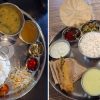Goa is abuzz with excitement as vintage bike and car owners, users, collectors and fans are decking […]

NOURISH TO FLOURISH! RECIPES FOR GOOD NUTRITION!
MIND & BODY, HEART & SOUL, Oct 19- Oct 25 2024 October 18, 2024World Food Day!
On Oct 16, recognized globally as World Food Day, we had the privilege of speaking with Dr Amit Dias to understand the vital role that food plays in our lives. “We must nourish to flourish — healthy food not only energizes our bodies but also serves as our medicine,” he explains, highlighting what he calls ‘the recipe for good nutrition’. In this insightful discussion he breaks down the essential elements of a balanced diet and the impact of proper nutrition, fiber, on preventing disease and promoting health.
Q&A interview with Dr Amit Dias
This is truly food for thought, read on and share the knowledge.
Goan Observer: Why do we observe World Food Day on October 16 and what is its significance?
Dr Amit Dias: World Food Day is closely aligned with the United Nations’ Sustainable Development Goals (SDGs), particularly Goal 2: Zero Hunger, which aims to end hunger, achieve food security, improve nutrition, and promote sustainable agriculture by 2030. It’s also closely aligned to Goal 3 which concerns health and well-being. We cannot stay healthy if we ignore nutrition.
It’s observed every year on October 16 to mark the beginning of the Food & Agriculture Organization (FAO) of the United Nations in 1945. The goal is to raise awareness and mobilize efforts to ensure that all people have access to nutritious and sustainable food. Everyone needs to understand the basics of what constitutes Healthy Food.
Q: What is the current burden with regards to food insecurity and malnutrition globally and in our country?
A: According to the 2023 Global Report on food crises, around 735 million people worldwide experienced hunger in 2022, a rise from the previous year, and about 29.6% of the global population faces moderate to severe food insecurity. Malnutrition, particularly protein-energy malnutrition (PEM), affects children disproportionately, leading to stunted growth, wasting, and increased mortality.
In India, despite economic growth, hunger remains a persistent problem. The Global Hunger Index 2023 ranked India 107th out of 121 countries, with high levels of child stunting (35.5%), wasting (19.3%), and an under-five mortality rate of 4.7%. Food insecurity and malnutrition are compounded by economic disparities, poor access to healthcare, and insufficient nutritional knowledge.
Q: What is your recipe for good nutrition? In a nutshell what constitutes “healthy food?”
A: To ensure sure that you have healthy food, here is a summary of what you need to do.
H – Hydrate regularly: Drink plenty of water throughout the day to stay hydrated and support digestion and metabolism.
E – Eat a variety of food items: Incorporate a colorful range of fruits, vegetables, grains, and proteins to ensure a balanced intake of nutrients and antioxidants.
A – Avoid processed foods: Limit consumption of highly processed, sugary, and salty foods, which can contribute to health problems like obesity and diabetes.
L – Limit sugar and salt: Reducing added sugars and salt in your diet helps prevent cardiovascular diseases, diabetes, and hypertension.
T – Track your portions: Practice mindful eating by controlling portion sizes to avoid overeating and maintain a healthy weight.
H – Healthy fats: Include sources of good fats like nuts, seeds, avocados, and olive oil to support heart and brain health. Avoid trans fats.
Y – Yogurt and probiotics: Include fermented foods like yogurt, curd, to promote gut health and improve digestion.
F – Fiber-rich foods: Eat whole grains, fruits, and vegetables to promote digestion and prevent constipation and they feed your good gut flora.
O – Opt for lean proteins: Choose lean meats, fish, legumes and plant-based proteins to support muscle growth and repair.
O – Organic and local: Whenever possible, choose organic, locally grown foods to reduce exposure to pesticides and support sustainable agriculture.
D – Daily intake of fruits and vegetables: Aim for at least 5 servings of fruits and vegetables a day for essential vitamins, minerals, and antioxidants.
Q: Could you tell us about the Eat Right India movement?
A: The Eat Right India movement is an initiative led by the Food Safety and Standards Authority of India (FSSAI) to promote healthy eating habits. It is part of India’s larger strategy to combat malnutrition and food-related diseases. The campaign focuses on three pillars: “Eat Safe,” “Eat Healthy,” and “Eat Sustainable.” It aims to ensure food safety, encourage the consumption of nutritious and balanced diets, and promote environmentally sustainable practices in food production and consumption.
The movement educates the public on the harmful effects of excessive sugar, salt, and trans fats, and stresses the importance of consuming locally grown, seasonal, and organic foods. This initiative is part of the larger mission to reduce the burden of diet-related diseases in India.
Q: Which diseases are related to our diet?
A: Our diet is responsible for our immunity and indirectly can prevent infectious disease. For example, if you have low immunity there are higher chances of getting infections such as tuberculosis. It is a vicious cycle as infections further lower your immunity and lead to loss of appetite, which worsens the malnutrition.
Diet as you all know, plays a significant role in the development of several non-communicable diseases (NCDs) such as obesity, cardiovascular diseases (CVDs), type 2 diabetes, and cancers. Excessive consumption of processed foods, sugary beverages, and diets rich in unhealthy fats and low in fruits, vegetables and whole grains contribute to these conditions.
For instance, high sodium intake is a major risk factor for hypertension, which in turn increases the risk of heart disease and stroke. Low sodium is also a problem as it leads to hyponatremia and we need to strike the right balance. Similarly, high sugar intake is closely linked to the rising prevalence of diabetes. Proper nutrition is crucial to preventing and managing these NCDs, which are responsible for nearly 60% of deaths globally. We need to have a balanced diet. Our diet can be our medicine.
Q: Can you elaborate on this? How can diet be our medicine?
A: Diet acts as medicine by preventing and managing diseases, supporting mental health and promoting overall well-being. Nutrient-rich foods boost immunity, reduce inflammation, regulate weight, and maintain gut health. Tailored diets can manage conditions like diabetes and hypertension, while antioxidants and healthy fats protect cells and improve longevity.
Proper nutrition refers to a balanced intake of macronutrients (proteins, fats, and carbohydrates) and micronutrients (vitamins and minerals) that meet the body’s needs. A balanced diet includes a variety of fruits, vegetables, whole grains, lean proteins, and healthy fats. It should also be appropriate for the individual’s age, sex, health status, and level of physical activity.
Q: What is the Food Pyramid, and how does it guide a balanced diet?
A: The Food Pyramid is a visual representation of the ideal distribution of food groups in a daily diet. It emphasizes the need for variety, balance and moderation. At the base of the pyramid are whole grains, which should make up the largest portion of one’s diet. Above that are fruits and vegetables, followed by proteins such as lean meats, legumes, and dairy. Fats and sugars occupy the top of the pyramid and should be consumed sparingly.
The pyramid promotes a balanced diet by encouraging the intake of nutrient-dense foods while limiting the consumption of processed foods, sugary beverages and unhealthy fats.
Q: What is the global stance on nutrition, especially in relation to malnutrition and NCDs?
A: The World Health Organization (WHO) has always considered nutrition a key factor in achieving good health and well-being. WHO emphasizes that proper nutrition is critical for the prevention of malnutrition in all its forms (undernutrition, micronutrient deficiencies, and overweight/obesity) and the management of diet-related NCDs.
The WHO Global Action Plan for the Prevention and Control of NCDs sets clear goals for improving nutrition, including reducing salt, sugar, and unhealthy fats in diets and promoting the intake of fruits, vegetables, and whole grains. It also stresses the importance of early interventions, such as exclusive breastfeeding for infants and proper complementary feeding.
Q: What measures has the government of India taken to tackle the issue of nutrition?
A: India has implemented several policies and programs to address the issue of nutrition. The Integrated Child Development Services (ICDS) provides food, preschool education, and healthcare to children under six years of age, pregnant women, and lactating mothers. The Midday Meal Scheme offers nutritious meals to schoolchildren, ensuring that they receive adequate calories and nutrients to support their growth and learning.
Additionally, the National Nutrition Mission (Poshan Abhiyaan) aims to improve nutritional outcomes for children, pregnant women, and lactating mothers by reducing stunting, undernutrition, and anemia. The mission integrates various schemes, ensuring a more coordinated approach to combating malnutrition.
Q:What is your final message to our readers on World Food Day?
A: On World Food Day I appreciate the efforts made by Donald Fernandes through his Street Providence initiative to provide food for the hungry in the state of Goa and beyond. Access to safe, nutritious and sufficient food is a basic human right and we all have a role to play in promoting food security and preventing malnutrition. A well-balanced diet is essential not only for preventing malnutrition but also for combating the rise of diet-related diseases like diabetes and heart disease. Working towards nutrition for all is working towards health for all. Let us nourish to flourish !!
















